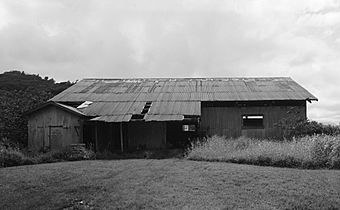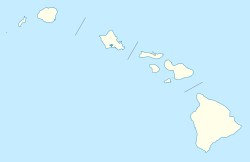Haraguchi Rice Mill facts for kids
Quick facts for kids |
|
|
Haraguchi Rice Mill
|
|
 |
|
| Location | Ohiki Rd., Hanalei, Hawaii |
|---|---|
| Area | less than one acre |
| Built | 1930 |
| NRHP reference No. | 83000252 |
| Added to NRHP | August 25, 1983 |
The Haraguchi Rice Mill is a historic building located on Ohiki Road in Hanalei, Hawaii, on the island of Kauai. It was once one of five rice mills in the beautiful Hanalei Valley. Built in 1930, this mill helped process rice for many years.
The Haraguchi Rice Mill is listed on the National Register of Historic Places. It was added to this list in 1983. This happened shortly after Hurricane Iwa damaged the mill in 1982. Even though the building collapsed, the important machines inside were mostly safe. People hoped it could be rebuilt.
Contents
The Start of Rice Farming in Hanalei
Many important buildings in Hanalei were built during the "rice era," which began in the 1860s. Hanalei was a farming area with lots of flat land. Farmers grew crops like tobacco, coffee, and sugarcane.
Around 1884, more Chinese farmers came to the area. They started renting land, and rice quickly became the main crop. The Haraguchi Rice Farm was started in Hanalei by Ine and Tomijiro Haraguchi. Their farm became the largest rice farm in the area. They also fished in Hanalei Bay.
The Haraguchi Rice Mill was rebuilt in 1930. It was a simple building with one room. This room had areas for milling rice, running the engine, and storing rice. It had a metal roof that came to a point. The Haraguchi Rice Mill closed in 1960. It was the last of the five rice mills in Hawaii to shut down. This happened because of competition from other places and damage from rice birds. These problems made it hard for the mill to make money.
How Rice Was Grown in Hanalei
Rice is usually ready to harvest about four months after it's planted. Farmers in Hanalei worked very hard. They planted rice all year long. When there was a lot of work, farmers would help each other out.
Rice seeds were first planted in special seedbeds. Farmers added natural fertilizer to help them grow. In a few days, the seeds would sprout into small plants called seedlings.
One big problem for rice farmers in Hanalei was a bird called the Chinese Sparrow. These birds would drink the milky liquid from young rice plants. They also ate the rice kernels as they grew. Farmers had to scare these birds away. They used cans filled with stones. These cans would make noise when they were shaken on strings.
The Hanalei River flows through the Hanalei Valley. This river made farming much easier because it provided plenty of fresh water. Almost everyone on the island could use this river for their farms.
Hawaii's Rice Economy
The Haraguchi Rice Mill was very important to the farming history of Hanalei. Chinese farmers first grew rice on the island. Years later, Japanese farmers took over. In 1879, farmers could sell a bag of rice for about $15 to $18.
Japanese farmers mainly grew rice for their own families to eat. Chinese farmers, however, often grew rice to sell or ship to other places.
Dealing with Natural Disasters
The Haraguchi Rice Mill was rebuilt in 1930 after a fire destroyed it in March of that year. After this, more disasters struck. In 1959, Hurricane Dot damaged the mill's roof and a part of its milling machine.
Then, in November 1982, Hurricane Iwa caused a lot of damage. The entire milling building collapsed. Luckily, the main milling machine was safe and could still work. In 1992, Hurricane Iniki also passed over the farm.
The Mill's Lasting Impact
The Haraguchi Rice Mill was the fifth rice mill in Hanalei, Hawaii. It helped many families and communities on the island. Even though it faced many disasters, the Haraguchi Rice Mill helped Hawaii's economy. It created jobs, brought in money from other places, and made rice a main food for Chinese and Japanese farmers.
Today, the farm no longer grows rice. Instead, it grows taro, which is a starchy root vegetable. The farm is now a non-profit business. It helps schools with personal development and offers "back to nature" visits. The farm still makes traditional dishes using fresh taro grown right there. It continues to honor its original values.
The Haraguchi Farm is still owned by the Haraguchi family's sixth generation. This farm is now over 100 years old! Besides growing taro, the farm in Hanalei, Hawaii, is used for nature tours. It's a non-profit place. The Haraguchi Farm now serves Hawaii as a fun place for tours, including for schools and other visitors. Hawaiian students also learn how to grow and harvest taro there. Growing taro also helps small businesses in the Hanalei community. Many products and old recipes are made from taro, which sell well in the area. The Haraguchi Family Farm is still active today.
- Historic American Engineering Record (HAER) No. HI-3, "Haraguchi Rice Mill, Hanalei River, Hanalei, Kauai County, HI", 12 photos, 4 measured drawings, 1 photo caption page


